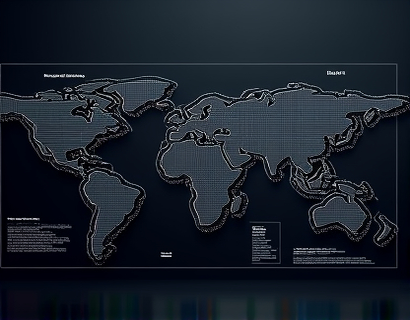Optimizing Complex Systems: Advanced Tools for Graph Theory and Fluid Dynamics Research
In the realm of complex systems, graph theory and fluid dynamics stand out as critical fields that drive innovation and understanding across various disciplines. Researchers and engineers in these areas face unique challenges due to the intricate nature of the systems they study. To address these challenges, advanced analytical tools have emerged, designed to streamline data analysis and enhance visualization. This article delves into the sophisticated tools available for graph theory and fluid dynamics research, highlighting how they can drive innovative discoveries and optimize performance in complex systems.
Graph Theory: A Foundation for Complex Systems
Graph theory, a branch of mathematics, provides a powerful framework for modeling and analyzing networks. In the context of complex systems, graphs represent entities and their relationships, enabling researchers to study everything from social networks to transportation systems. However, the complexity of these networks often requires advanced tools to manage and interpret the data effectively.
One of the key challenges in graph theory research is handling large-scale networks. Traditional methods can become cumbersome and inefficient when dealing with thousands or millions of nodes and edges. To overcome this, modern software tools have been developed that leverage parallel computing and distributed systems. These tools can process vast amounts of data quickly, allowing researchers to analyze complex networks in a fraction of the time it would take with conventional methods.
For instance, tools like GraphX, built on Apache Spark, provide a high-level API for graph-parallel computation. GraphX enables researchers to perform common graph operations such as shortest path, connected components, and community detection on large datasets with ease. The ability to scale computations across multiple nodes makes GraphX an invaluable resource for handling big data in graph theory.
Enhanced Visualization for Graph Theory
Visualization is a crucial aspect of graph theory research, as it helps in understanding the structure and dynamics of networks. Advanced visualization tools go beyond basic plotting by providing interactive and customizable interfaces. These tools allow researchers to explore different aspects of the graph, such as node properties, edge weights, and community structures, in real-time.
Tools like Gephi and NetworkX with its visualization capabilities offer powerful features for graph visualization. Gephi, for example, supports large-scale network visualization and provides a wide range of layout algorithms to display graphs in an intuitive manner. NetworkX, when used with libraries like Matplotlib and Plotly, can generate high-quality visualizations that are both informative and aesthetically pleasing.
Interactive visualization tools such as D3.js and Cypher Dashboard take this a step further by allowing users to manipulate the graph dynamically. Researchers can zoom in and out, highlight specific nodes or edges, and apply various filters to focus on particular aspects of the network. This level of interactivity is essential for gaining deep insights into complex systems.
Fluid Dynamics: Simulating and Analyzing Fluid Behavior
Fluid dynamics is another critical field that benefits significantly from advanced analytical tools. Simulating fluid flow and heat transfer involves solving complex partial differential equations, which can be computationally intensive. Modern software tools have made it possible to perform high-fidelity simulations and analyze the results with greater accuracy and efficiency.
One of the primary challenges in fluid dynamics research is the numerical solution of the Navier-Stokes equations, which govern fluid motion. These equations are nonlinear and often require sophisticated numerical methods to obtain stable and accurate solutions. Advanced solvers like OpenFOAM and ANSYS Fluent have been developed to tackle these challenges.
OpenFOAM is an open-source computational fluid dynamics (CFD) tool that provides a wide range of solvers and algorithms for simulating fluid flow, heat transfer, and related phenomena. Its modular design allows users to extend and customize the software to suit specific research needs. OpenFOAM supports both steady-state and transient simulations, making it suitable for a broad range of applications, from aerodynamics to biomedical fluid mechanics.
ANSYS Fluent, a commercial CFD software, offers a user-friendly interface and advanced features for simulating complex fluid dynamics problems. It includes a comprehensive set of turbulence models, multiphase flow capabilities, and coupling with structural mechanics. The software's ability to handle large-scale simulations and provide detailed visualizations makes it a popular choice among engineers and researchers.
Multiphysics Simulations and Coupled Systems
Many real-world problems involve coupled physical phenomena, where fluid dynamics interacts with other fields such as structural mechanics, electromagnetics, and thermodynamics. Advanced tools that support multiphysics simulations are essential for accurately modeling these complex systems.
Software like COMSOL Multiphysics stands out in this domain. COMSOL allows users to create and solve multiphysics models by combining different physical domains within a single simulation. This capability is particularly useful for studying phenomena such as fluid-structure interaction, heat transfer in fluids, and electromagnetic fluid dynamics. The software's extensive library of built-in physics interfaces and user-friendly modeling environment make it accessible to both beginners and experienced users.
Another notable tool is ABAQUS, which is widely used for finite element analysis (FEA) and can handle multiphysics problems with ease. ABAQUS provides advanced solvers for fluid dynamics, structural mechanics, and thermal analysis, allowing researchers to simulate coupled systems with high precision. Its ability to handle large-scale problems and provide detailed post-processing tools makes it a powerful resource for complex system analysis.
Data Analysis and Machine Learning Integration
The integration of advanced data analysis techniques and machine learning algorithms with traditional CFD and graph theory tools has opened new avenues for research. These techniques can help in identifying patterns, making predictions, and optimizing system performance.
Tools like TensorFlow and PyTorch have become popular for implementing machine learning models in fluid dynamics and graph theory research. Researchers can use these frameworks to develop custom algorithms for tasks such as turbulence modeling, network prediction, and anomaly detection. By combining machine learning with traditional simulation methods, researchers can enhance the accuracy and efficiency of their analyses.
For example, machine learning models can be trained on simulation data to predict fluid flow behavior under different conditions, reducing the need for extensive computational resources. Similarly, graph neural networks (GNNs) can be applied to analyze and predict properties of complex networks, providing insights that are difficult to obtain through traditional methods.
Visualization and Data Exploration
Effective visualization and data exploration are crucial for understanding the results of complex simulations. Advanced tools provide a range of visualization techniques that help researchers interpret and communicate their findings.
Paraview is an open-source tool that excels in visualizing large datasets from CFD simulations. It supports a wide range of visualization techniques, including volume rendering, surface rendering, and contour plots. Paraview's scripting capabilities allow users to automate complex visualization workflows, making it a powerful tool for data exploration.
VisIt is another visualization tool that is particularly well-suited for scientific data. It offers advanced visualization features such as adaptive mesh refinement, anisotropic filtering, and interactive visualization of multidimensional data. VisIt's ability to handle large datasets and provide real-time interaction makes it an excellent choice for researchers working with high-fidelity simulation data.
Conclusion
The advancement of analytical tools for graph theory and fluid dynamics research has revolutionized the way scientists and engineers approach complex systems. These tools not only streamline data analysis and enhance visualization but also pave the way for innovative discoveries and performance optimization. By leveraging these advanced solutions, researchers can tackle challenges that were previously intractable, leading to breakthroughs in various fields.
As the complexity of systems continues to grow, the demand for sophisticated analytical tools will only increase. Continued development and innovation in this area will be crucial for advancing our understanding of complex systems and driving technological progress.










































